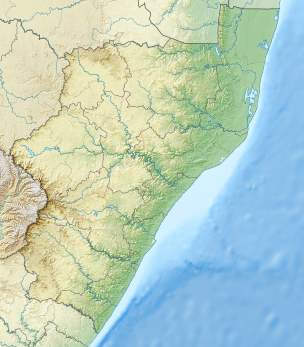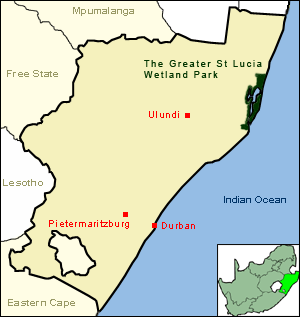Kosi Bay
Kosi Bay is a series of four interlinked lakes in the Maputaland area of KwaZulu-Natal, South Africa.
| Kosi Bay | |
|---|---|
 Location of Kosi Bay in KwaZulu-Natal | |
| Location | KwaZulu-Natal, South Africa |
| Nearest city | Maputo (across border), then Richards Bay, South Africa |
| Coordinates | 27°0′0″S 32°50′0″E |
| Governing body | Ezemvelo KZN Wildlife |
| Designated | 28 June 1991 |
| Reference no. | 527[1] |

Ecology
The lakes form part of the iSimangaliso Wetland Park, a UNESCO World Heritage Site. The closest town is Manguzi, some 13 kilometres (8.1 mi) away from it. Kosi Bay estuary is only 2 kilometres (1.2 mi) from the Mozambique border. It is possible to walk from the estuary to Ponta do Ouro in only an hour or so. It is one of the quietest beaches in South Africa. The Kosi River Mouth is known as "the aquarium" because of the clarity of the water and the abundance of fish species.
Bird species in the area include the palm-nut vulture, Pel's fishing owl, white-backed night-heron, and kingfishers. Duiker, hippopotamus, crocodiles and bull sharks are also present, and loggerhead and endangered leatherback sea turtles lay their eggs on the beach. The Bay is noted for its aggressive bull shark population. The sharks are locally known as zambesi.[2] Whale sharks and manta rays also visit the area. Whale watching to target mainly humpback whales and dolphins is a growing industry in Kosi Bay region.
The Kosi palm has the largest leaf of any plant. Endemic species include the Kosi cycad and Kosi fern. It is one of very few places on earth where five different species of mangrove trees are found in one area. Kosi Bay is particularly famous for the traditional Tsonga fish traps built to trap fish moving in and out of the estuary with the tide. The Tsonga people, who have made this land their home for more than 1000 years, are experts in fish traps and the construction of fishkraal.[3]
History
Kosi Bay is the cultural capital of the ancient Tsonga Tembe kingdom. This is the original and natural home of the Tsonga people and their fish traps. The history of Vatsonga people on this land dates back some 1000 years.[4] Kosi Bay and Maputo Bay can be considered one land-area, traditionally belonging to the Africans. Kosi Bay was also known as Tembeland or Thongaland, but the name fell into disuse in early 1900s. When Britain colonised South Africa, Kosi Bay was annexed to Natal, while Maputo was annexed to Mozambique. The Vatsonga people lost large tracts of land on St Lucia Bay in 1895 when Britain took the land and restricted the Tsonga people to Kosi Bay only. Before 1895, the Tsonga people controlled the whole of St Lucia Bay, known today as Greater St Lucia Wetland Park. Today, Kosi Bay continues to be the proud home of the Tsonga people. The Tembe Traditional Authority (led by Chief Israel Tembe, a descendant of the ancient Tembe kingdom) exercises political control over the area. The Tembe Elephant Park testifies to this ancient Tsonga history.
- Fishtraps

External links
References
- "Kosi Bay". Ramsar Sites Information Service. Retrieved 25 April 2018.
- Whales, whale sharks, dolphins are sighted off the coast.Most shark-infested beaches Couriermail
- Junod, HA 1913, The Life of a South African Tribe: The Psychic Life, Imprimerie Attinger Freres, Neuchatel.
- Mathebula, Mandla (2002), 800 Years of Tsonga History: 1200-2000, Burgersfort: Sasavona Publishers and Booksellers Pty Ltd.
- "Kosi Bay Nature Reserve, KwaZulu Natal". SA-Venues.com. Retrieved 2007-05-06.